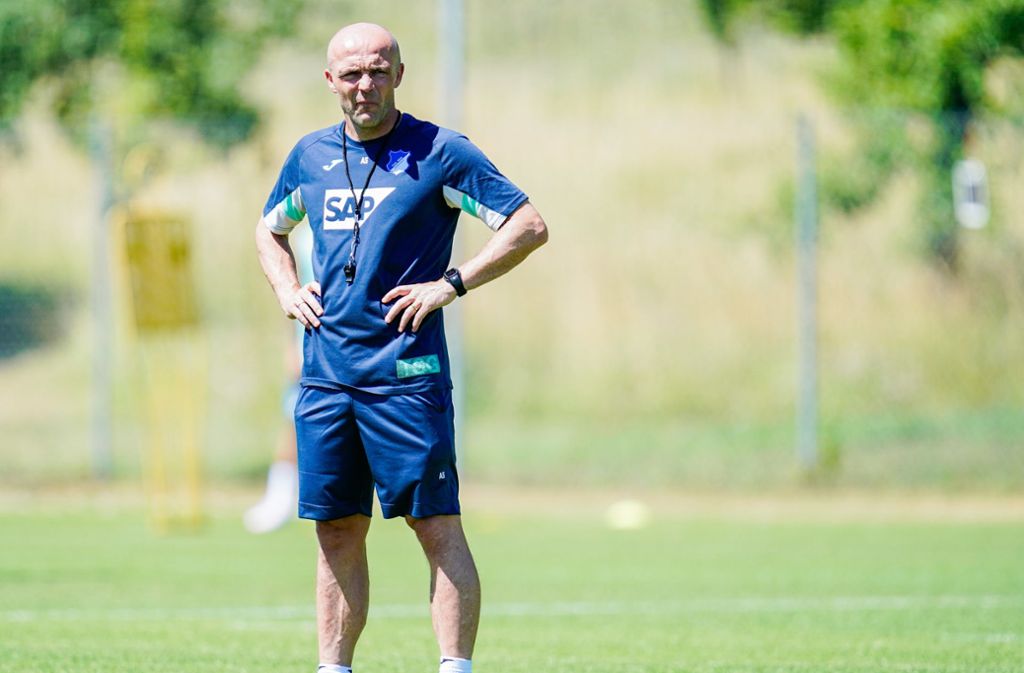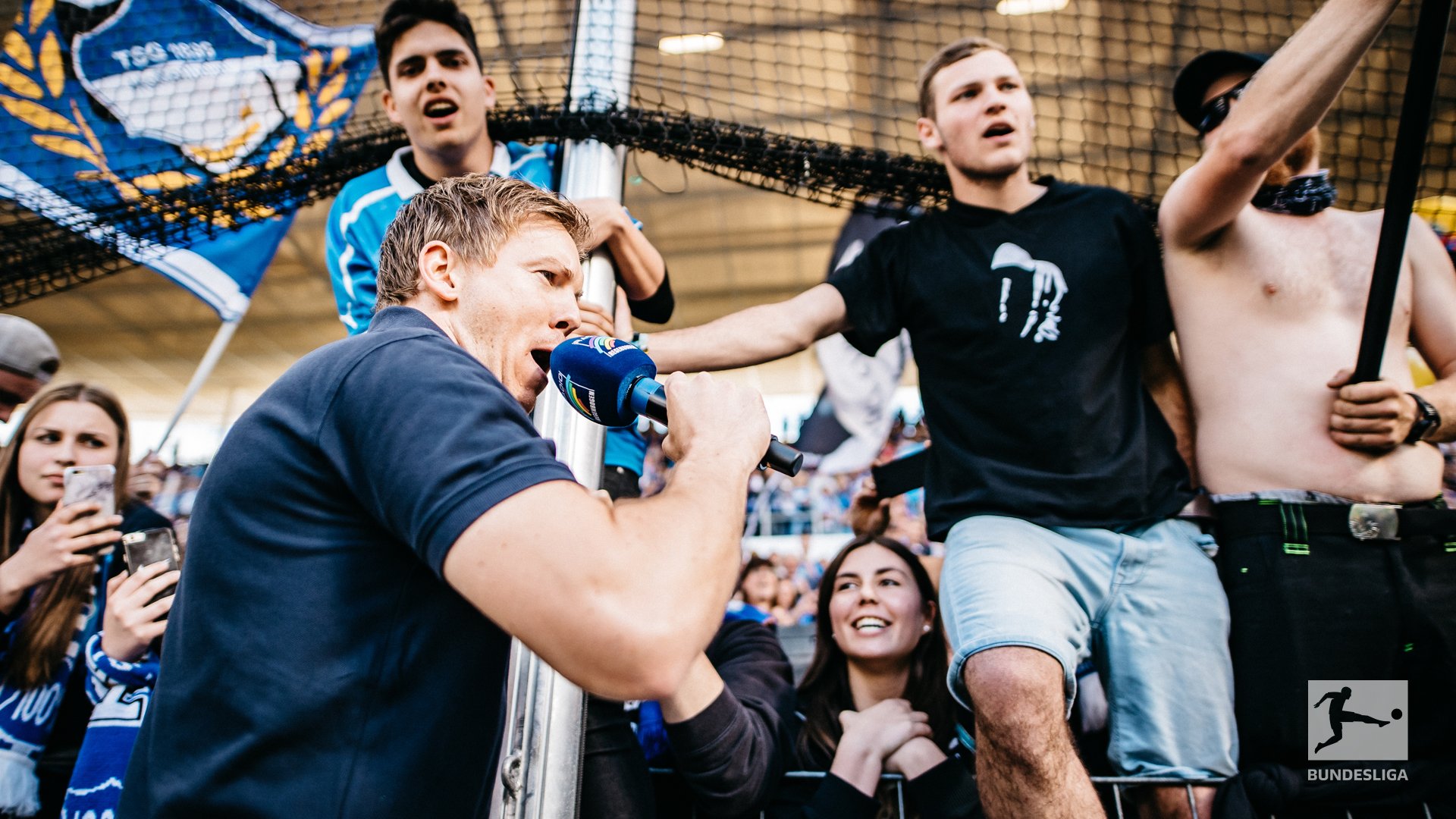Alfred Schreuder’s intriguing Hoffenheim

Alfred Schrueder was forced to begin his tenure in Sinsheim without Andrej Kramaric while Adam Szalai and Joelinton had been sold. During pre-season, Schreuder introduced highly fluid and coordinated build-up routines. In their Bundesliga opening day loss away to Eintracht Frankfurt, Schreuder continued on this path but switched to an ultra-defensive style against Bayer Leverkusen. Schreuder certainly had issues with the understanding of his squad and introducing his style as he looks to step out of the shadow of his predecessor, Julian Nagelsmann.
Build-up play
In Hoffenheim’s opener away to Frankfurt, Schrueder implemented a build-up shape of Oliver Baumann receiving possession in between the two-wide centre-backs while the most central midfielder, Kevin Vogt pushed into the base of midfield. This proved to be an extension of Julian Nagelsmann’s methods of giving Baumann and Vogt increased ball-playing responsibilities. In the picture above, you can see this method in play, the keeper creates an extra player in the first wave while Vogt and the deeper-lying wing-back are marked. This allows Hoffenheim to invite pressure with Vogt dropping deeper to create a passing lane for the free-man in midfield.
Schreuder sought to create elaborate build-up routines through clever player spacing and movement with quick central combinations as well as a higher focus on build-up play than under Nagelsmann. In the picture above, Hoffenheim’s back three have created a triangle as Hoffenheim have neatly placed triangles all over the pitch in their build-up shape. The wide centre-back can play the ball out wide for a wide combination as there are opportunities for blind-sided movements for a through ball to the striker pulling away from the opposition centre-backs for layoff opportunities. Schreuder’s team looked to circulate the ball and play out of pressure situations but through switches in between a back three and four, Hoffenheim have failed to replicate these structures since their opening game.
More recently, Hoffenheim have tried to be more direct with their build-up, working early passes into the striker who will pull away from the opposition centre-backs to drop into space and receive the ball. However, these automatisms rely on timing of the pass in between the lines, the striker dropping into space and the players around the striker making themselves available for layoffs. Against Bayern Munich, Hoffenheim failed to work these movements properly and frequently lost possession. Layoffs are an essential fundamental of Hoffenheim’s ball circulation, players are placed close to each other in the structure so the player in possession can work possession through the lines as Hoffenheim will frequently layoff the ball to work possession into the higher areas.
Alfred Schreuder prefers to play with a midfield three of highly efficient passing midfielders like Florian Grillitsch, Sebastian Rudy, Lukas Rupp as well as Dennis Geiger and Diadie Samassekou when he returns from injury. This allows Hoffenheim to rotate in the six-space to evade pressure while switching from a 3+1 to 3+2/3+3 to evade pressure when the centre-backs need more passing options or to work wall passes. The defensive three chain will normally circulate the ball amongst themselves until central passing options become available before Hoffenheim spread the ball out wide in midfield.
In the above picture, Hoffenheim are attempting to play through pressure with players aligned in triangles all over the pitch. Vogt pushing into the six space allows Grillitsch to move higher and wider while opening a passing lane to the ball-far wide centre-back or the goalkeeper, so the home team can switch play. If the attacker holds his position, Vogt moves into space and has an overload with Grillitsch which allows the duo to work a quick layoff combination before attempting to play one of the strikers in behind.
Rupp and Rudy are on the ball-near side and far side, respectively so this allows Hoffenheim to establish pivotal connections with the wide centre-back, wing-back and attacker to progress play. Rupp and Rudy as the wide midfielders will move into the wide areas connecting play while also becoming conduits to switch play to the opposite flank. When Hoffenheim are in the opposite half, they will move more central and closer to Grillitsch to circulate possession to create space while making runs into the box.
Hoffenheim approach play through crosses
Hoffenheim’s main issues involved their attacking play as until recently, they were last in the Bundesliga expected goals table. The departures of Joelinton and Adam Szalai meshed with an injury to Andrej Kramaric meant they were forced to rely on summer signing, Ihlas Bebou while Jurgen Locadia and Sargis Adamyan adapted to the Bundesliga. The role of Bebou as a lone striker proposed an issue within itself as he started next to Robert Skov (who now deputises at wing-back). Bebou tended to enjoy dropping deep to receive possession while moving into the channels to chase loose balls as Hoffenheim lacked a presence within the box.
Hoffenheim seek to create opportunities with early direct crosses as well as low crosses and without a striker to challenge the opposition in the box, Schreuder had an issue. In the above picture, Bebou is out wide as Hoffenheim lack a true presence in the 2v3 situation in the centre. Skov and a midfielder who lack any aerial profligacy are forced to challenge in a situation where they have meagre opportunities for success while Samassekou who is a deeper-lying midfielder has pushed into the ten space behind them. Hoffenheim have attacking endeavour with all of their outfield players hemmed into the opposition half with little chance to create a proper opportunity.
Now as Kramaric has returned from injury while Adamyan and Locadia have quickly assimilated to the Bundesliga, all of Hoffenheim’s strikers have accrued at least two goals apiece as the team from Sinsheim have moved up the expected goals table and the league table. Hoffenheim have also better understood Schreuder’s demands for early and low crosses. Hoffenheim work quicker and more elaborate three-man passing interchanges on the flank to create low crossing situations from the by-line while they have strikers who draw markers and finish opportunites with better runs and finishing inside the box. From early crosses, they also have more aerially proficient attackers to win aerial duels to create opportunities inside the box. However, they still have attackers who are adept at moving into the wide areas to chase loose balls, dropping deeper to receive passes while also making intelligent runs in behind from long-balls as their set of multi-faceted attackers allow them to be multi-dimensional in attack.
Hoffenheim defensive shape
Hoffenheim do not necessarily employ a high-press but maintain a medium to high block to prevent the opposition from playing through the centre. Schreuder’s defensive shape was frequently altered with his indecision with deploying a two centre-back or three centre-back system. Against Frankfurt, they utilised a 5-4-1 defensive block before switching to a 4-4-2 against Bayer Leverkusen with Pavel Kaderabek acting as a right winger with the right wide centre-back becoming a fullback. Hoffenheim utilised a 4-1-4-1 defensive shape away to Bayern Munich as they have now settled on a Nagelsmannian 5-3-2 which could switch to a 4-4-2 situationally.
Despite all the change, the tenets of Hoffenheim’s defensive shape remain the same, to deny the opposition central access and force them wide with a rigid and tight defensive block. Schreuder’s side also deny Hoffenheim access to the central channels with a high defensive line which is close to the midfield line while defenders are tasked with surging forward to win possession when the ball is played into their zone. Benjamin Hubner has proved the most skilled at this as it was a talent honed under Nagelsmann with his tigerish lunges to win possession.
Hoffenheim do not seek to engage the opposition centre-backs or goalkeeper as their strikers are passive, maintaining a horizontal body shape as they only engage the opposition when the ball is moved into the midfield line or into the wide areas for lateral pressure. The focus is on maintaining the tight defensive block to win the ball and counter into space rather than winning possession in the high areas at the expense of their defensive shape.
In the picture above, Hoffenheim are defending in a traditional Nagelsmannian 5-3-2 which they have implemented in recent games. The Sinsheim-based club are restricting their opposition in the central spaces in a high and compact line without an aggressive high-press. The focus is denying the opposition access into the six space as well as the two centrally placed midfielders who have been marked by Hoffenheim’s midfielders. The defence have pushed higher to deny the opposition access into the pockets while the wingers can act as auxiliary wingers when the ball is moved to their flank by pushing up to engage their marker.
Hoffenheim counter-pressure and counter-attacking
Hoffenheim’s counter-pressing phase is important due to the fact Schreuder’s team do not employ a high press. Once, Hoffenheim lose possession in the higher areas of the pitch, they will constrict on the man in possession in order to win back possession. Situationally, Hoffenheim will aggressively hassle the man in possession or players will simply hold their position if they are situationally close the player in possession and allow him to drive into their space before engaging. Once they regain possession, they will seek to spread or switch the ball or create high quality opportunities with through balls. Their midfield three will push forward to constrict the space and regain possession while the two strikers will situationally attack a player’s blind side to regain possession.
Hoffenheim thrive in working quick passing interchanges after regaining possession to quickly progress play by finding the free man and moving the ball into space. This allows them to evade the opposition’s counter-press and launch quick breaks where they can spread the ball to create low or early crossing opportunities for their strikers or drive at the opposition defence in the central spaces and allow their strikers to make runs in behind. Schreuder’s side have scored a number of goals from counter-attacking and counter-pressing situations including goals against Hertha Berlin and Bayern Munich. They create their highest quality opportunities from counter-attacking situations.
Conclusion
Alfred Schreuder’s tenure at Hoffenheim underwent a rough start but his team have found form with players returning from injury and the Dutchman adjusting to his playing staff. He has committed to a back three and certain fundamentals of play which have allowed his team to surge upwards on the Bundesliga table as well as the expected goals table. His time as an assistant to astute managerial minds like Erik ten Hag and Julian Nagelsmann has been well spent as he has developed since his last tenure as a Head Coach at FC Twente.












